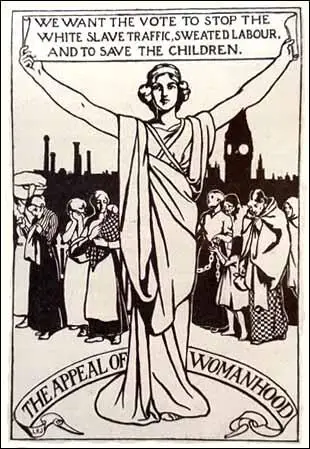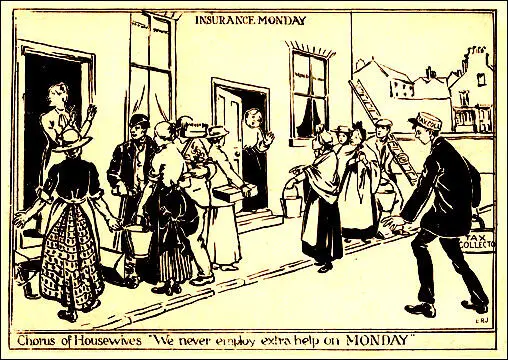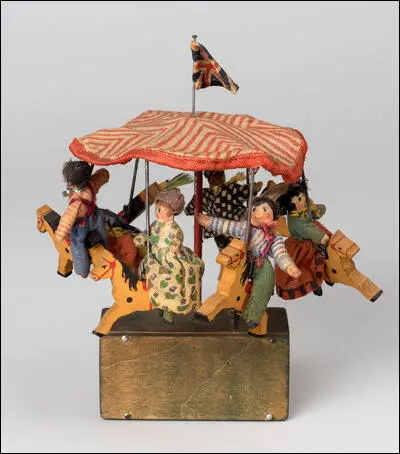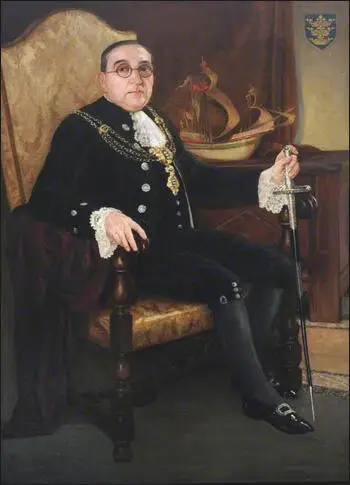Louise Rica Jacobs
Louise Rica Jacobs was born in the Sculcoates area of Kingston-upon-Hull, in the East Riding of Yorkshire on 3rd June 1880. She was the middle of three surviving children born to Isabella Kisch Jacobs (1854-1933) and Benjamin Septimus Jacobs (1851-1931). Her siblings were Ethel (1878) and Bethel (1881). Her father was an architect and surveyor. In 1902, Benjamin Jacobs designed both the Western Synagogue in Linnaeus Street, Hull, and the adjacent Jewish school. (1)
Louise Rica Jacobs: Artist
Louise was educated at home by a live-in governess, before studying at the Hull School of Art and in 1903 she was awarded a Government free studentship at the Royal College of Art. A winner of a National silver medal and book prize for figure design in tempera and in 1905 a prize for "the best set of sketches in black and white" awarded in a competition held by the RCA Sketching Club. (2)
Suffrage Atelier
Alfred Pearse, Laurence Housman and Clemence Housman formed the Suffrage Atelier (an artists' collective campaigning for women's suffrage) on 8th May 1909. (3) It claimed: "The object of the society is to encourage Artists to forward the Women's movement, and particularly the Enfranchisement of Women, by means of pictorial publications. Each member of the Society shall undertake to give the Society first refusal of any pictorial work intended for publication, dealing with the women's movement. In return the artist will receive a certain percentage of the profits arising from the sale of her or his work." (4)
As Lisa Tickner, the author of The Spectacle of Women: Imagery of the Suffrage Campaign (1987) has pointed out that along with the Artists' Suffrage League: "Women were able to organise collectively and contribute their professional skills to the suffrage campaign. They designed, printed and embroidered all manner of political material; they taught each other the requisite skills from hand-painting to needlework; they designed major demonstrations and took part in them in their own contingents; they lent their studios for meetings and contributed to exhibitions, bazaars and fund-raising activities." (5)
The Suffrage Atelier was based at 1, Pembroke Cottages, Edwardes Square, the home of Laurence Housman and Clemence Housman. Laurence described his sister as the organistion's "chief worker" and the main "banner-maker" of the women's suffrage campaign. (6) In 1911 she made a new banner for the Actresses' Franchise League. "Stencilled in the AFL colours of pink, white, and green, it shows the twin masks of tragedy and comedy framed with wreaths and ribbons." (7)
Louise Jacobs became a member of the Suffrage Atelier and was involved in designing banners for the organisation. On 6th May 1911, Herbert Asquith, the prime minister of the Liberal Party government, announced that in the next session of Parliament he would introduce a Bill to enfranchise the four million men currently excluded from voting and suggested it could be amended to include women. (8)
In an attempt to put pressure on the government, the Women Social & Political Union (WSPU) decided to organise a Women's Coronation Procession march through London on 17th June 1911, just before King George V's coronation. Christabel Pankhurst later wrote in Unshackled (1959): "Never had a year begun in so much hope. It might be coronation year for the women's cause as well as for the King and Queen." (9)
Louise Jacobs designed the "Appeal of Womanhood" for the Coronation Procession which cited the impelling reasons why women wanted the vote - "To stop the White Slave Traffic, Sweated Labour and to Save the Children". According to Elizabeth Crawford, the author of Art and Suffrage: A Biographical Dictionary of Suffrage Artists (2018): "The Appeal of Womanhood was issued both as a black and white postcard, which is sometimes found partially coloured, and, in at least two colourways, as a poster. The image was also emblazoned on a banner carried by the 'Brown Women' on their Edinburgh to London march in the autumn of 1912." (10)

Initially most members of the Suffrage Atelier were members of the Women Social & Political Union. However, several members became critical of its arson campaign and left the organisation. Laurence Housman, one of the co-founders of the Suffrage Atelier was especially critical of the WSPU. He was especially upset when Mary Richardson attacked the painting, Rokeby Venus by Diego Velázquez at the National Gallery. Housman described the "stab in the back given to the Rokeby Venus" as hurting his artistic feelings. "After that came the burning of churches, and I felt myself obliged to cease subscribing to WSPU funds." (11)
The Suffrage Atelier decided to hold an exhibition of Louise Jacobs's work for the women's suffrage movement in Shepherd's Bush. The Suffragette reported that one of the visitors to the exhibition was Rosika Schwimmer, the corresponding secretary of the International Woman Suffrage Alliance (IWSA). It added that Jacobs was the "draughtsman of many of the Atelier's publications, showed some very fine specimens of her work in water colour and lithograph." (12)
The Suffrage Atelier now became closely associated with the militant but non-violent, Women's Freedom League (WFL) with which it embarked on the joint venture of a "pictorial supplement" with its newspaper, The Vote. (13) In 1912 the WFL worked with the Atelier on a new poster campaign. Charlotte Despard, the leader of the WFL, wrote that their joint campaign would bring the Atelier's work "into more intimate relation" with the movement and the public as a whole, while at the same time illustrating "the advance of the Cause and the fluctuations of the political barometer". (14)
During this period Louise Rica Jacobs contributed several drawings to The Vote including Chorus of Housewives that appeared on the front-page of the newspaper in December 1912 and signed "LRJ". (15) This drawing refers to the insurance provisions introduced by David Lloyd George under the 1911 Insurance Act by which domestic employers had to pay for insurance stamps for their servants. (16)

Jacob's cartoon was supporting the Women's Tax Resistance League whose members refused to pay several different taxes including national insurance, Imperial taxes dog licences, duties on carriages and carts and inhabited house duty. In other branches, members tended to make their resisting colleagues' cases the focus of particular campaigns, as in Brighton where the entire branch rallied to support the actions of their secretary and treasurer who had their goods seized and in lieu of their uncollected inhabited house duty in Edinburgh the members resisted paying taxes on the branch's bank interest, and amiably dismissed the Sheriff Officer when "he called to expostulate with us." (17)
In 1913, Louise Rica Jacobs completed a mural, 8ft by 14ft, entitled "The granting of the Commune to the citizens of London by Prince John in 1191" for the first-floor hall of the Commercial Street School, a London Board school. Louise Rica Jacobs was described at the time as a "a Hull artist associated with the Suffrage Atelier, a women’s suffrage group, won the commission in competition." (18) Jacobs also had an exhibition at the Walker Gallery. One newspaper stated she had "craftsmanship of a quite distinguished order, and real charm of style." (19)
A London street directory published in 1915, records "Miss Louise Jacobs, artist, sharing the building at 25 Edith Grove, Chelsea, S.W. London, with five other female artists and a man named George Barker. The other women artists recorded at 25 Edith Grove, Chelsea, were Edith Mary Davey, Gwendoline Muriel Parnell, Dora McLaren, Esther Willoughby and Beatrice Pritchard." (20) In 1915 Jacobs had two full-page illustrations published in The Graphic (21) and The Illustrated London News (22)
Pamona Toys
In 1915 Louise Jacobs teamed up with Mary Wheelhouse, a member of the Artists' Suffrage League and a member of the Women's Guild of Arts, went into a formal partnership as toymakers, trading as "Pomona Toys" with a shop at 64 Cheyne Walk in Chelsea. Her name was associated with several wooden toys, such as a "Merry-go-round" and a "Washing Day Set". (23)

A reviewer in the Journal of the Royal Society of Arts that year expressed the opinion that "some of the toys strike one as being more beautiful than fit for their purpose. Some of the charming little models exhibited by Miss MV Wheelhouse and Miss Louise Jacobs, for instance, suggest that the average child could only be trusted to gaze at them from a distance, except on rare occasions when there was some one by.” (24)
The Graphic reported on the "Royds Dolls" that thge company produced: "One can only say of them that they are the right kind of dolls, each one a perfect individual, with clothes that take off and on. The most attractive feature of these toys is that they go not only to the heart of the child-lover, but even more directly to the heart of the child. The war has been considered only in the sense that the prices are singularly modest." (25) The partnership was dissolved by mutual consent in 1922. (26)
Later Life
After the First World War Louise Jabobs returned to Hull and had an exhibition at the Municipal Art Gallery, in May 1925. The local newspaper reported: "Miss Jacobs includes in her collection some pencil drawings of streets in Dinant, St. Malo, and other French towns. They are all attractive drawings, and form one of the most interesting sections of the range of ninety odd pictures. Of the paintings, two are prominent – 'The Baby Clinic', and a group of workmen during a meal hour in Marlborough Avenue. A number of pencil and water-colour pictures are also attractive." (27) In 1929 she was commissioned to paint the portrait of Alderman Benno Pearlman. (28)

Louise Rica Jacobs was living at Camberwell House, Peckham Road, London, when she died on 17th August 1946. Her brother, Bethel Lyon Jacobs, a civil engineer, was named as one of the executors of her will. Louise Rica Jacobs, left effects valued at £41,902 16s 6d. (29)
Primary Sources
(1) The Suffragette (8th November 1912)
Frau Rosika Schwimmer and others from the First International Congress of Men's Societies for Women's Suffrage attended the last monthly At Home of the Suffrage Atelier and expressed keen admiration for the posters and postcard exhibition which occupied all the downstairs premises at 6, Stanlake Villas, Shepherd's Bush. Upstairs Miss Louise Jacobs draughtsman of many of the Atelier's publications, showed some very fine specimens of her work in water colour and lithograph.
(2) The Vote (9th November 1912)
The monthly "At Home" of the Atelier was held as usual on the last Thursday on the month at its own workshops 6 Stanlake Villas. On the occasion the members and friends of the Atelier, from all the Suffrage societies – for the Atelier works for and with all shades of Suffragists – were entertained by humorous and other recitations by Miss Eilian Hughes, who is about to start a speakers' class at the Atelier on Thursdays at 5.30 p.m. Mrs. Ambrose Gosling's beautiful lace and wonderful needlecraft were displayed upstairs. A one-woman show of clever water-colours and fine lithographs by Miss Louise Jacobs filled another room. Downstairs, Suffrage posters and postcards of the Atelier's own publications were on sale and on view, many of these bring cartoons for the Vote and posters for the Caxton Hall meetings and the International Suffrage Fair at Chelsea Town Hall…. An exhibition of the Atelier's posters is now on view at the Edinburgh Branch of the Women's Freedom League.
(3) The Westminster Gazette (10th March 1914)
At the Walker Galleries… there is a very attractive display of drawings in line and colour by Louise Jacobs. In these there is a craftmanship of a quite distinguished order, and real charm of style.
(4) The Graphic (18th December 1915)
It would be difficult to find more enchanting Christmas toys than those made by the two artists, Miss M. V. Wheelhouse and Miss Louise Jacobs, now on view at 64, Cheyne Walk. No child could resist the dolls' merry-go-round, in which rag dolls with resplendent woolly hair cling to their wooden chargers in an ecstasy of speed! A flower shop with real sand and an unlimited supply of potted plants rivals a dolls' theatre, and is, perhaps, surpassed by a Covent Garden Market cart laden with supremely realistic vegetables to take out and put in at will.
The "Royds" Dolls need a chapter to themselves. One can only say of them that they are the right kind of dolls, each one a perfect individual, with clothes that take off and on. The most attractive feature of these toys is that they go not only to the heart of the child-lover, but even more directly to the heart of the child. The war has been considered only in the sense that the prices are singularly modest.
(5) Hull Daily Mail (20th May 1925)
A Hull artist, Miss Louise Jacobs A.R.G.A., is exhibiting a collection of her drawings and paintings in conjunction with the poster exhibition at the Municipal Art Gallery, Carr Lane.
Miss Jacobs includes in her collection some pencil drawings of streets in Dinant, St. Malo, and other French towns. They are all attractive drawings, and form one of the most interesting sections of the range of ninety odd pictures.
Of the paintings, two are prominent – "The Baby Clinic", and a group of workmen during a meal hour in Marlborough Avenue. A number of pencil and water-colour pictures are also attractive.

